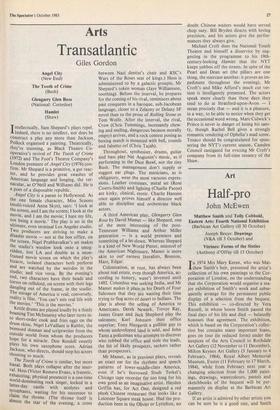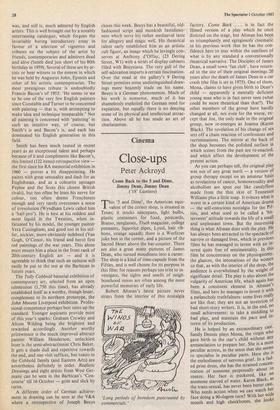Art
Half-pro
John McEwen
Matthew Smith and Tolly Cobbold, Eastern Arts: Fourth National Exhibition (Barbican Art Gallery till 30 October) Joseph Beuys: Drawings (V&A till 3 October) and
Vitrines: Forms of the Sixties (Anthony d'Offay till 15 October) 'En 1974 Mrs Mary Keene, who was Mat- 1 thew Smith's heir, presented the artist's collection of his own paintings to the Cor- poration of London, on the understanding that the Corporation would organise a ma- jor exhibition of Smith's work and subse- quently arrange for the permanent public display of a selection from the bequest. This exhibition — co-directed by Vera Russell, in whose house Smith passed the final days of his life and died — belatedly honours that agreement. The exhibition, which is based on the Corporation's collec- tion but contains many important loans, goes on tour (in reduced form) under the auspices of the Arts Council to Rochdale Art Gallery (12 November to 11 December), Milton Keynes Art Gallery (3 January to 4 February, 1984), Royal Albert Memorial Museum, Exeter (11 February to 17 March, 1984), while from February next year a changing selection from the 1,000 paint- ings, drawings, watercolours, pastels and sketchbooks of the bequest will be per- manently on display at the Barbican Art Gallery.
If an artist is admired by other artists you can be sure he is a good one, and Smith was, and still is, much admired by English artists. This is well brought out by a notably entertaining catalogue, which forgoes the invariably boring introductory essay in favour of a selection of vignettes and tributes on the subject of the artist by friends, contemporaries and admirers dead and alive (Smith died just short of his 80th birthday in 1959). Several of these are by ar- tists or bear witness to the esteem in which he was held by Augustus John, Epstein and other of his artistic contemporaries. The most prestigious tribute is undoubtedly Francis Bacon's of 1953: 'He seems to me to be one of the very few English painters since Constable and Turner to be concerned with painting — that is, with attempting to make idea and technique inseparable.' Not all painting is concerned with 'painting' in such an intuitive way, of course, but Smith's is and Bacon's is, and each has dominated his English generation in this field.
Smith has been much touted in recent years as an exceptional talent and perhaps because of it and compliments like Bacon's, this limited (122 items) retrospective view the first since his RA memorial exhibition in 1960 — proves a bit disappointing. He paints with great sensuality and dash for an Englishman, and as a colourist upstages PepIce and the Scots (his closest British rivals), but too often he loses his nerve for colour, too often deems Frenchiness enough and very rarely overcomes a sense of irresolution (Wyndham Lewis called him a 'half-pro'). He is best at his reddest and most liquid in the Twenties, when in- fatuated by his model, the younger painter Vera Cuningham; and good too in his stif- fer, stickier, more obviously indebted (Van Gogh, O'Conor, his friend and hero) first red paintings of the war years. This alone must ensure him a place in the front rank of 20th-century English art — and it is agreeable to think that such an opinion will easily be put to the test at the Barbican in future years.
The Tolly Cobbold biennial exhibition of contemporary art, selected from an open
submission (1,750 this time), has already established itself as a worthy, though lesser, complement to its northern prototype, the
John Moores Liverpool exhibition. Profes-
sional competence perhaps best sums up the standard. Younger aspirants provide most of this year's sparks: Graham Crowley and Alison Wilding being the brightest and rewarded accordingly. Another worthy prizewinner is the much improved abstract painter William Henderson; unluckiest loser is the semi-abstractionist Chris Baker.
It gets a shade dull and repetitive towards the end, and one visit suffices, but toasts to the Cobbold family (and Eastern Arts) are
nevertheless definitely in order. Realistic Drawings and eight artists from West Ger- many can be seen in the Barbican's 'Con- course' till 16 October —, grim and slick by turns.
A different order of German achieve- ment in drawing can be seen at the V&A where a retrospective of Joseph Beuys closes this week. Beuys has a beautiful, old- fashioned script and monkish fastidious- ness which serve his rather mediaeval taste for allegory and magic well. His theatrical talent early established him as an artistic cult figure, an image which he lovingly con- serves at Anthony d'Offay, (23 Dering Street, WI) with a series of display cabinets filled with Beuysiana. The very gall of the self-adoration imparts a certain fascination. Over the road at the gallery's 9 Dering Street premises some undistinguished draw- ings more brazenly trade on his name. Beuys is a German phenomenon. Much of his work is nonsense, much of it has shamelessly exploited the German need for expiation, but equally there is no denying some of its physical and intellectual attrac- tion. Above all he has made an art of charlatanism.







































 Previous page
Previous page